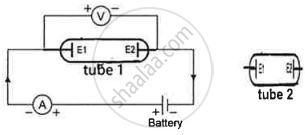Advertisements
Advertisements
Question
The voltage - current readings of a certain material are shown in the table given below:
| Voltage (V) | 10 V | 20 V | 30 V |
| Current (I) | 2 A | 3 A | 4 A |
Study the table.
- State whether the conductor used is ohmic or non-ohmic.
- Justify your answer.
- State Ohm's law.
Solution
a. Here, the ratio of `V/1` for different readings is:
(i) `(10 V)/(2 A) = 5 Ω`
(ii) `(20 V)/(3 A) = 6.66 Ω`
(iii) `(30 V)/(4 A) = 7.5 Ω`
Here, the ratio is not constant, so the conductor is non-ohmic.
b. The ratio of `V/I` remains constant for all values of V and I in an ohmic conductor. Plotting current I against potential difference V results in a straight line that passes through the origin on a graph. Thus, the conductor in question is not ohmic.
c. Ohm's law states that, under constant physical conditions and conductor temperature, the current flowing in a conductor is directly proportional to the potential difference applied across its ends.
APPEARS IN
RELATED QUESTIONS
Name the physical quantity whose unit is "ohm".
Name the law which is illustrated by the above V−I graph.
Tick(✓) the correct choice in the following:
Ohm's law is applicable to
Define the following:
(i) Coulomb
(ii) Ohm
State the relation correlating the electric current flowing in a conductor and the voltage applied across it. Also, draw a graph to show this. relationship.
State Ohm’s law.
The resistance of a resistor is reduced to half of its initial value. If other parameters of the electrical circuit remain unaltered, the amount of heat produced in the resistor will become ______.
A current of 0.8 A flows in a conductor of 40 Ω for 1 minute. The heat produced in the conductor will be ______.
The circuit depicted in the figure is employed for studying Ohm's Law. Instead of using a standard resistor, a student opts for a glass tube filled with mercury (tube 1), connected to the circuit through two electrodes E1 & E2. He records the readings of the ammeter and voltmeter, thereby calculating the resistance. The student repeats the experiment by substituting tube 1 with tube 2, where the same amount of mercury fills the tube 2.

Neglecting internal resistance of the cell use (> or < or =) to compare
- the resistance in both the cases.
- the voltmeter readings in both the cases.
- the specific resistance in both the cases.
